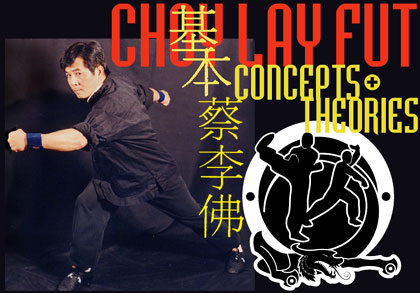

 |
 |
|
home | instructors
| choy lay fut | ving
tsun | curriculum | news
| gallery | supplies
| links | contact
|
|
|
Choy Lay Fut Concepts and TheoriesThe core of the Choy Lay Fut system contains a set of ten basic strikes that permeates throughout all of its handsets and fighting combinations. Each of the ten basic strikes, or the ten elements, maintains its own unique characteristics. Just as the jab in boxing differs both in its generation of power and line of attack from a hook, each element within the Choy Lay Fut system also maintains its own distinctiveness. Specialized drills and sparring are utilized within the Choy Lay Fut curriculum to develop the proper generation of power, timing, and distancing skills necessary for actual combat. During serious confrontations, a Choy Lay Fut practitioner's main aim will be incapacitating of the opponent. The techniques, theories, and concepts within the Choy Lay Fut system are developed to cause damage. The concepts of distancing and positioning are essential to the successful use of the ten basic elements or techniques found within the Choy Lay Fut system. When discussing distancing and positioning within Choy Lay Fut, two concepts must be learnt and understood by the practitioner, they are invasion, and evasion. Invasion is done through the trapping of the opponent’s limbs, taking over his center of gravity (balance) through aggressive (invasive) body positioning, or both. Invasion is done mostly through forward movement with slight angular stepping to cut into an opponent’s center of gravity. Evasion is done by placing yourself in a position where you can avoid your opponent’s currently available lines of attack. This allows you to strike your opponent as he is striking or while he attempts readjusting his body positioning to attack you again. There are seven main lines of evasion. Evasion must place you within a particular distance to your opponent after he initiates an attack. If you place yourself too close to an opponent, it will hinder your own attack. If you place yourself too far from an opponent, you will give room for him to readjust and continue his attack. To avoid the aforementioned dilemmas, one must effectively hypothesize the distance between you and your opponent after he initiates his attack to utilize each of the evasion lines effectively. An effective strike is one that impacts the opponent with the most power. The energy of the swing should be focused and transferred square upon the intended target. As there is a “sweet spot” on the baseball bat that transfers the maximum kinetic energy of the player’s swing into a ball, the same can be said of a punch or a kick. For instance, a sau chue’s (round-house punch) impact area (or the “sweet spot”) is the fist or the top of the forearm. Conversely, striking the opponent with your bicep will not be effective as there is not enough speed generated in that area to injure your opponent. In combat, one must be able to judge distances and adjust stepping and positioning to ensure that one will strike effectively. To strike effectively, one must be familiar with the stances and structures found within Choy Lay Fut and then learn to place oneself at the optimum range from a moving opponent to execute one’s techniques. In addition to concepts governing distancing and positioning, the “gate” and “continuous” theory of attacking governs Choy Lay Fut’s offensive once contact is made and the gap is bridged. The "gate theory" is a systematic division of the human body into specific sections for attacking and defending. The arms and legs are perceived as gates closing to defend vulnerable areas. The "gate theory" teaches that four limbs cannot “close” all the gates simultaneously, and an opponent’s reaction to an attack on particular gates will leave others open to damage. The "continuous theory" teaches one to aggressively force through a “gate” rather than going around it.
|
| © 2000 Philip Ng and Sam Ng. All rights reserved. |
| Website maintained by Studio Straightblast5 |